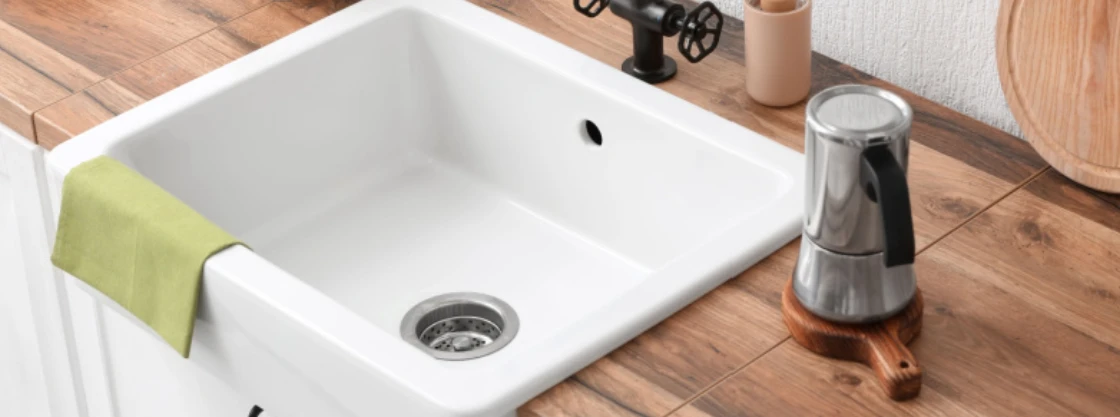
Molly Maid offers expert sink cleaning tips for a sparkling kitchen.
|
There’s more to the sink than just washing dirty dishes. The professional cleaning experts at Molly Maid® know how important it is to clean your sink drain, faucets, sink, and disposal regularly.
Daily Routine for A Gleaming Sink
Having a clean kitchen sink requires a quick daily scrub. After washing the dishes, rinse any food residue in the sink with warm water. Use a non-abrasive sponge and dish soap to wipe down the entire sink, looking for any residue buildup. If you see residue buildup, use a small amount of baking soda and water to create a paste and let it sit for a few minutes before scrubbing and rinsing.
Instructions How to Clean the Kitchen Sink
Cleaning the kitchen sink is as easy as baking soda and water and is important to rid the sink of growing bacteria. These simple tips will ensure the sink stays clean daily between visits from Molly Maid's professional cleaning service.
How to Clean a Stainless-Steel Kitchen Sink
Stainless steel sinks may require extra care. Here are cleaning tips for your stainless steel sink:
- Sprinkle baking soda or a mild abrasive cleaner like Bar Keepers Friend onto the sink.
- Using a soft sponge, scrub the sink toward the grain (if visible) to avoid scratching the stainless steel.
- For stains, create a paste by mixing baking soda and water and apply it to these areas. Let it sit for a few minutes before scrubbing gently.
- Rinse the sink thoroughly with warm water to remove all traces of the cleaner.
- To remove water spots, wipe the sink with a cloth dipped in white vinegar or use a stainless steel cleaner designed for sink surfaces.
- Dry the sink with a clean towel.
- Add a small amount of mineral or olive oil to a cloth and buff the sink for added shine.
How to Clean a White Porcelain Kitchen Sink
White sinks tend to stain due to their color, so regular cleaning and maintenance are necessary to keep them looking their best.
- Sprinkle baking soda or a mild abrasive cleaner onto the sink's surface.
- Using a soft sponge or cloth, scrub the sink in circular motions, paying extra attention to any stains or spots.
- For tougher stains, you can create a paste by mixing baking soda and water and applying it directly to the stained areas. Let it sit for a few minutes before scrubbing gently.
- Rinse the sink thoroughly with warm water to remove all traces of the cleaner.
- To further clean and brighten the sink, you can use a mixture of equal parts water and white vinegar. Spray or pour this solution onto the sink and let it sit for a few minutes before rinsing.
- Dry the sink with a clean towel to prevent water spots and streaks.
How to Clean Kitchen Faucets and Handles
Avoid using abrasive cleaners or chemicals on kitchen faucets and handles because that can damage the finish. Regular cleaning and maintenance will help keep your faucets and handles looking clean and functioning.
To clean kitchen faucets and handles, follow these steps:
- Mix a solution of equal parts warm water and mild dish soap in a bowl or bucket.
- Moisten a soft cloth or sponge with the soapy water solution and gently wipe down the faucet and handles. Pay attention to any areas with stains or grime buildup.
- Use an old toothbrush dipped in the soapy water solution to scrub gently for hard-to-reach areas or stubborn stains.
- Rinse the faucet and handles thoroughly with clean water to remove any soap residue.
- If there are mineral deposits or limescale buildup on the faucet or handles, you can use a mixture of equal parts water and white vinegar. Soak a cloth or paper towel in the vinegar solution and wrap it around the affected areas. Let it sit for 15-30 minutes to dissolve the deposits. Then, rinse with clean water.
- Dry the faucet and handles with a clean, soft cloth or towel to prevent water spots or streaks.
How to Clean a Sink Drain and Disposal
Want to avoid that smelly sink drain? Kitchen drain cleaning is a straightforward process. Here's a step-by-step guide to help you:
- Start by gathering rubber gloves, a sponge or scrub brush, baking soda, white vinegar, salt, and boiling water.
- Turn off the power to the disposal.
- Remove any visible debris or objects from the disposal using tongs or pliers.
- Pour 1/2 cup of baking soda into the garbage disposal, followed by one cup of white vinegar. The mixture will create a foaming reaction that helps break down grime and odors.
- Allow the baking soda and vinegar mixture to sit in the disposal for an hour.
- Put on the rubber gloves and remove any visible debris from the smelly sink drain using your fingers or tweezers.
- Sprinkle a handful of salt down the drain, followed by boiling water. The hot water helps dissolve grease and flush away any remaining residue.
- Turn on garbage disposal and rinse with cold water for one minute.
- Cut a lemon in quarters, put it down the garbage disposal, and turn it on.
- For an extra clean sink drain, pour more boiling water down to help flush out any remaining debris.
Help When You Need It
If you are feeling overwhelmed at the prospect of cleaning your home, don’t worry because the pros at Molly Maid are ready to help! Our professionals can perform single cleanings, weekly cleanings, and special event cleaning services. Our team of insured, licensed, and uniformed housekeepers is ready to tackle the toughest chores so you don’t have to with your satisfaction guaranteed with our Neighborly Done Right Promise®.
To request a free house cleaning estimate in your area, please contact your local Molly Maid today.
